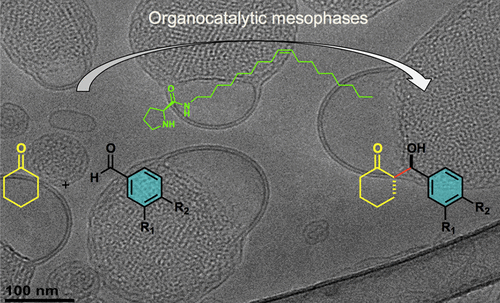当前位置:
X-MOL 学术
›
ACS Appl. Mater. Interfaces
›
论文详情
Our official English website, www.x-mol.net, welcomes your feedback! (Note: you will need to create a separate account there.)
Lipidic Mesophases as Novel Nanoreactor Scaffolds for Organocatalysts: Heterogeneously Catalyzed Asymmetric Aldol Reactions in Confined Water
ACS Applied Materials & Interfaces ( IF 9.5 ) Pub Date : 2018-01-19 00:00:00 , DOI: 10.1021/acsami.7b19740 Michael Duss 1 , Livia Salvati Manni 1, 2 , Laurent Moser 1 , Stephan Handschin 2 , Raffaele Mezzenga 2 , Henning J. Jessen 3 , Ehud M. Landau 1
ACS Applied Materials & Interfaces ( IF 9.5 ) Pub Date : 2018-01-19 00:00:00 , DOI: 10.1021/acsami.7b19740 Michael Duss 1 , Livia Salvati Manni 1, 2 , Laurent Moser 1 , Stephan Handschin 2 , Raffaele Mezzenga 2 , Henning J. Jessen 3 , Ehud M. Landau 1
Affiliation

|
The unique molecular architecture of lipidic cubic phases (LCPs) and their cubosome dispersions comprise a well-defined, curved bilayer that spans the entire three-dimensional (3-D) material space, encompassing a network of two periodic, curved, and nonintersecting 3-D aqueous channels. The ensuing large lipid/water interfacial area makes these biomaterials an interesting matrix for the lateral immobilization of organocatalysts to catalyze organic reactions in confined water. Herein, we report for the first time the design, synthesis, assembly, and characterization of catalytically active LCPs and cubosomes and demonstrate their applicability as self-assembled, biomimetic, and recyclable nanoreactor scaffolds. Small-angle X-ray scattering, cryo-transmission electron microscopy, and dynamic light scattering were applied for the characterization of the mesophases. These mesophases can be recycled and enable efficient catalytic activity as well as modulation of the diastereo- and enantioselectivity for the aldol reaction of several benzaldehyde derivatives and cyclohexanone in water.
中文翻译:

脂质中间相作为新型纳米反应器支架的有机催化剂:承压水中非均相催化的不对称醛醇缩合反应
脂质立方相(LCP)及其立方微粒分散体的独特分子结构包括定义明确的弯曲双层,该双层覆盖整个三维(3-D)材料空间,包含两个周期性,弯曲且不相交的网络3 -D水通道。随之而来的大的脂质/水界面面积使这些生物材料成为侧向固定化有机催化剂以催化承压水中有机反应的有趣基质。在这里,我们首次报告了催化活性LCP和小体的设计,合成,组装和表征,并证明了它们可作为自组装,仿生和可回收的纳米反应器支架应用。小角X射线散射,低温透射电子显微镜,用动态光散射法对中间相进行表征。这些中间相可以循环使用,并能实现高效的催化活性,并调节几种苯甲醛衍生物和环己酮在水中的醛醇缩合反应的非对映和对映选择性。
更新日期:2018-01-19
中文翻译:

脂质中间相作为新型纳米反应器支架的有机催化剂:承压水中非均相催化的不对称醛醇缩合反应
脂质立方相(LCP)及其立方微粒分散体的独特分子结构包括定义明确的弯曲双层,该双层覆盖整个三维(3-D)材料空间,包含两个周期性,弯曲且不相交的网络3 -D水通道。随之而来的大的脂质/水界面面积使这些生物材料成为侧向固定化有机催化剂以催化承压水中有机反应的有趣基质。在这里,我们首次报告了催化活性LCP和小体的设计,合成,组装和表征,并证明了它们可作为自组装,仿生和可回收的纳米反应器支架应用。小角X射线散射,低温透射电子显微镜,用动态光散射法对中间相进行表征。这些中间相可以循环使用,并能实现高效的催化活性,并调节几种苯甲醛衍生物和环己酮在水中的醛醇缩合反应的非对映和对映选择性。



























 京公网安备 11010802027423号
京公网安备 11010802027423号